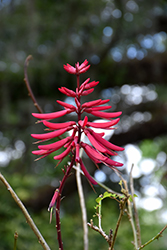It's all about ...
plants

Height: 8 feet
Spread: 8 feet
Sunlight:
![]()
![]()
Hardiness Zone: 10a
Other Names: Coralbean, Cherokee Bean, Red Cardinal
Description:
A deciduous to semi evergreen shrub, or a small tree in frost free environments; roots are hardier so this variety will die back and re-emerge in spring in colder areas; dazzling red flower clusters and seed pods from spring to fall; attracts hummingbirds
Ornamental Features
Coral Bean features showy clusters of scarlet tubular flowers at the ends of the branches from late winter to late spring. The fruits are showy scarlet pods which fade to black over time, which are carried in abundance from early summer to mid fall. Its glossy pointy leaves remain green in colour throughout the season.
Landscape Attributes
Coral Bean is a multi-stemmed perennial with a more or less rounded form. Its medium texture blends into the garden, but can always be balanced by a couple of finer or coarser plants for an effective composition.
This is a relatively low maintenance plant, and should only be pruned after flowering to avoid removing any of the current season's flowers. It is a good choice for attracting bees, butterflies and hummingbirds to your yard. Gardeners should be aware of the following characteristic(s) that may warrant special consideration;
- Spiny
- Self-Seeding
Coral Bean is recommended for the following landscape applications;
- Mass Planting
- Hedges/Screening
- General Garden Use
Planting & Growing
Coral Bean will grow to be about 8 feet tall at maturity, with a spread of 8 feet. It has a low canopy with a typical clearance of 1 foot from the ground. Although it is technically a woody plant, this fast-growing plant can be expected to behave as a perennial in our climate if planted outdoors over the winter, usually regrowing from its base (crown) the following year. As such, gardeners should take into consideration that it will perform differently than it would in its native habitat.
This plant does best in full sun to partial shade. It is very adaptable to both dry and moist locations, and should do just fine under typical garden conditions. This plant does not require much in the way of fertilizing once established. It is particular about its soil conditions, with a strong preference for sandy, acidic soils. It is somewhat tolerant of urban pollution. Consider applying a thick mulch around the root zone in winter to protect it in exposed locations or colder microclimates. This species is native to parts of North America, and parts of it are known to be toxic to humans and animals, so care should be exercised in planting it around children and pets..
This plant is not reliably hardy in our region, and certain restrictions may apply; contact the store for more information.
